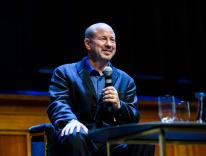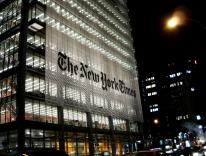By now, you might think, celebrated filmmaker Ken Burns should be able to concoct historical documentaries in his sleep. With acclaimed series like The Civil War, Baseball, and Jazz under his belt, interlacing sepia photographs and snippets of scholarly interviews must be child's play—right?
Not so, apparently. Burns confesses to struggling with a thorny challenge while crafting his latest project, The National Parks: America's Best Idea, a twelve-hour, six-part series that starts airing September 27 on PBS. The problem? The scenery was just too pretty.
The footage, shot over the course of six-plus years, captured landscapes so spectacular that they threatened to overshadow the documentary's storytelling, Burns said in a July phone interview. “Beauty is seductive, and beauty in some cases can be distracting,” he observed, speaking from the New Hampshire offices of Florentine Films. “It was one of the huge dynamics of the editing room. We wanted to make sure that the beauty didn't derail narrative—that it served it—and, at the same time, that our narrative wasn't so single-minded in its purpose that it didn't leave room for the just awe-inspiring beauty.”
No one who watches even a portion of The National Parks—which has an accompanying Web site (www.pbs.org/nationalparks) and book (The National Parks, published by Alfred A. Knopf)—will quibble over the term “awe-inspiring.” Waterfalls plunging down looming crags; dizzyingly deep orange canyons soaking up the sun; wolves, bears, and other animals loping through meadows—the scenes can be breathtaking. And though the series also features contemporary interviews, archival photographs, and historical writings intoned by actors (Tom Hanks, John Lithgow, Star Trek alum George Takei, and more), the camera work does sometimes create a mood of beatific languorousness.
Still, a hefty amount of narrative saunters out, too, courtesy of Burns and his collaborator Dayton Duncan, the writer and producer who initially proposed that the parks might be a rich documentary topic in line with the American phenomena that other Burns works had chronicled. (The fact that The National Parks will premiere amid increasing worldwide concern about the environment is a happy coincidence, Burns says; ecological angst played no role when he leapt at Duncan's suggestion, around a decade ago.)
The storytelling kicks off with anecdotes about the nineteenth-century travelers whose enthusiasm for Yosemite Valley and the geysers of the Yellowstone region spurred Congress to safeguard those areas in 1864 and 1872. The film goes on to deal with such matters as the 1906 Antiquities Act, which allowed Theodore Roosevelt to place land under federal protection with the stroke of a pen; the fierce battles between conservationists and entrepreneurs over areas like the Smoky Mountains; the post-World War II boom in visitors that menaced park resources; and the absorption of historically significant sites (such as Little Rock Central High School) into the park system. A particularly lively section in the sixth and final episode tells how President Jimmy Carter, after signing the 1980 Alaska National Interest Lands Conservation Act, was burned in effigy by some furious Alaskans.
But while The National Parks does survey grand-scale happenings, it also revels in tales of idiosyncratic individuals. We meet the likes of Stephen Mather, a wealthy public-relations genius who, as the first National Park Service director, shelled out his own money to further the Service's aims. And Lancelot Jones, the grandson of a slave, who inherited choice Florida waterfront and, refusing to sell it to rich-as-Croesus developers, allowed for the creation of Biscayne National Park. And then there are the villains, such as Ralph Cameron, who filed scores of mining claims and set up his own toll road in an attempt to turn the Grand Canyon into his personal cash register. (The Supreme Court ruled against Cameron's claims.)
The most striking personality in the series is perhaps John Muir, the Scottish-born naturalist and writer who founded the Sierra Club, took Teddy Roosevelt camping, and inspired so many conservationists that he has been called the Father of the National Parks. Muir's attitude toward nature was downright mystical. He rhapsodized about trees, and compared nature-despoiling humans to the money-changers Jesus threw out of the Temple. He once wrote that “in God's wildness lies the hope of the world.”
“John Muir saw the spirituality inherent in granite,” pronounces writer Terry Tempest Williams in one of her moments of onscreen punditry.
The idea that nature can furnish a vision of transcendence, while simultaneously revealing the interconnectedness of the cosmos, turns up again and again in the documentary, in the solemn voiceovers quoting historical figures, and in the contemporary interviews with park rangers, scholars, and writers (including Nevada Barr, a former park ranger and the author of a mystery series featuring a ranger).
“The original impulse to set aside the parks was indeed spiritual and religious,” Burns told me, noting that only later did Americans come to associate the park system with patriotism, economic development, and environmental concerns.
In the nineteenth century, when the parks movement got underway, Americans suffered from something of an inferiority complex. “We didn't have the cathedrals of Europe,” Burns said, “what we had were these spectacular cathedrals of nature.” With freedom of religion coded in the country's DNA, he noted, many people were inspired “to find God not in a cathedral made by man, not in the devotion that men impose on one another, but in these magnificent places where one was free to be with oneself.”
In thinking about U.S. history, he added, “we tend to play up the political freedoms and play down the religious freedoms, because of the way, at least in our political arena, so many of those religious dimensions have metastasized. We forget the early extraordinary release of energy that came from this idea that you could—the genius of America!—worship God the way you wanted. And the national parks seemed very much a part of that.”
Given widespread anxiety about global warming, has a pragmatic view of nature displaced a more mystical understanding? Burns doesn't think so. People still have spiritual epiphanies in the midst of wildness, he said, “but we do it on our own classically modern, narcissistic terms. The parks have become, in a way, for those people who participate in them, these places where they've had some kind of transformational moment. They can't exactly put their finger on it, or label it in the spiritual or religious dimension, but it's there,” as a treasured childhood recollection or a memory of feeling both insignificant and “bigger in the scheme of things.”
But if Burns discerns the spiritual dimensions of places like Mount McKinley and the Teton Range, he and his film are even more ardent about the preserves' civic significance. Open to, and essentially owned by, Americans of all backgrounds and classes, the parks are living, growing emblems of democracy, the program asserts.
“The parks seem to be the Declaration of Independence applied to the landscape, a purely democratic expression that couldn't have happened anywhere else but here,” Burns told me. “Unless you are in an experiment of trying to figure out how the people themselves can govern themselves...you're not going to be able to say, ‘Let's set aside this land for everybody.' That only comes from people fooling around with democracy.”
If the parks embody political idealism, they can also transmit it, Burns suggested, quoting Stephen Mather's assertion that the parks are “schoolrooms of Americanism.” As conduits of national aspirations, these public wildernesses may resonate particularly strongly in moments like our current economic crisis, the filmmaker thinks. The Great Depression, after all, turned out to be a boom time for the parks. “Attendance went up, I think in part because you could go there and realize it was going to be OK,” Burns said.
Of course, back in the 1930s, Americans had fewer ways to fill their leisure time. Can the likes of giant sequoias, volcanic cinder cones, and bighorn sheep—or national monuments like the Lincoln Memorial—compete successfully with Twitter, YouTube, and HBO? Burns acknowledges the problem.
“It's just getting physically harder to round everybody up and load them into the station wagon—now it's the minivan-and go visit the parks, as so many families [once] did,” he said, “because everyone is tied in to their own systems-their own iPhones and iPods and video games and cell phones and TV sets and surfing the net.”
But a viewer might guess that The National Parks will improve the odds of that minivan vacation. The documentary's argument that the parks embody democracy is persuasive and, even to a jaded TV critic, inspiring. And what with all that resplendent scenery—well, I've started planning a trip to Yellowstone.
Please email comments to [email protected] and join the conversation on our Facebook page.
Share
Previous Story
War As Narcotic
Next Story
Free to Be Fathers?

